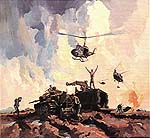RAEME CORPS MARCH
|
Depending on the speed of your connection to the Internet
there may be a small delay before the March starts playing. It needs Adobe Flash Player installed From 1953 until 1967, the Corps March authorised for use by the RAEME was the same as the REME Corps March, an arrangement of
While wanting to maintain its traditional link with REME, the Corps wished to have its own march. The DEME Conference of 1959 (Brig J.C. Bendall, O.B.E) decided that Auprés de am Blonde should be replaced. A search for an alternative was unsuccessful until Lt Col R.A. Newman (Director of Music), overheard a remark in Officers Mess at the Army Apprentices School, Balcombe where RAEME was referred to "as the Army's backroom boys". Reminded of a modern song called See What the Boys in the Back Room Will Have he made an arrangement of it which was performed for the 1961 DEME Conference. Lt Col R.A. Newman's arrangement of Lilliburlero and See What the Boys in the Back Room Will Have was approved as the Corps March on 31 August 1967 (AAO No61) Vide:- Craftsman of the Army : the Story of RAEME – ISBN 1 86333 057 7 – page250
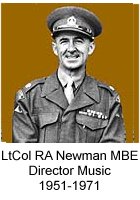
LtCol RA Newman MBE
Director Music 1951-1971 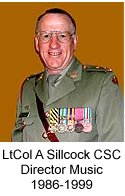
LtCol A Sillcock CSC
Director Music 1986-1999 The version played here has been provided by the AABC Association and prepared for the Internet by LtCol Tony Sillcock CSC. We thank them. The performance is from the LP, Action Army recorded in the EMI studios, Sydney, in 1968 by a composite band of Army musicians conducted by the Director of Music, LtCol RA Newman MBE. The LP is no longer catalogued. Reginald Newman joined the Australian Army in 1950 after service with the British Army and secondment to the Canadian Army during World War 2. He was initially bandmaster of the Central Command Band in Adelaide. In 1951 was appointed Director of Music and given the charter to organise a proper training and operating structure for Army bands. His term saw the establishment of the Army School of Music in 1953, the creation of the Australian Army Band Corps in 1968 and the conversion of bands from brass bands to military bands during the 1960s. He was awarded the MBE for his services and retired in 1971. Tony Sillcock enlisted in 1966 as a National Serviceman and after completing basic training at 2 RTB and the Army School of Music was posted to 8 RAR Band and served in Malaysia. On completion of National Service he enlisted in the ARA with postings to several bands and at the Army School of Music. He later commanded the Defence Force School of Music. He was appointed Director of Music – Army in December 1986, retiring in 2000 after 34 years service including 13 years as Director. Career highlights include
Awarded the Conspicuous Service Cross in 1997, he remains active in community music and is presently secretary of The AABC Association. Lillibulero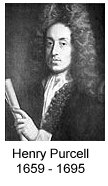
Henry Purcell
1659–1695 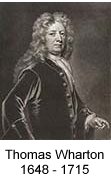
Thomas Wharton
1648–1715 Lillibulero is attributed to the noted English composer, Henry Purcell. The music was arranged by Purcell in 1678 and is based on an old traditional Irish jig. The lyrics were written ten years later by Thomas Wharton as a satire on Irish resistance to English rule and the Irish defeat at the Battle of the Boyne. BackgroundLillibulero is a product of its times being rooted in centuries' old Irish resistance against English rule – and later, republicanism and protestanism – and the eventual defeat of James The Second's and the Irish Army by William of Orange's parliamentary and Dutch forces. Henry Purcell was born in 1659 a year after the death of Oliver Cromwell, the creator of The New Army, a puritan, a republican and The Lord Protector of England, Scotland and Ireland. His forces deposed and beheaded Charles 1 in 1649 replacing the monarchy with the Commonwealth of England, a republican government to rule England, Scotland, and Ireland. Following Cromwell's death (1658), a dispute between the Grandees of the New Army and the Commons (Parliament) resulted in the Army, under Gen John Lambert, closing the doors of the Parliament. The Commons then made a pact with the Army's Gen George Monke, the Governor of Scotland, to install Charles 11 (with limited powers). Lambeth's forces deserted him, Parliament was reconvened and Charles 11 was crowned. On Charles' death in 1685, his brother, James, – a Roman Catholic, King of Scotland and Duke of Normandy and allied to Louis XIV of France – ascended to the throne as James 11, King of England, King of Scotland and King of Ireland with the approval of the Commons. A struggle over the succession to the throne with other royalist claimants was defeated by the standing Army that James raised. He appointed Roman Catholics to senior positions in his Army which led to a falling out with the Commons who petitioned William, the Dutch protestant, Prince of Orange, James son-in-law, and governor of the main provinces of the Dutch Republic. A Union of Parliamentarians and William's Dutch forces deposed James in 1688. James 11 had earlier appointed Richard Talbot, Earl of Tryconnel (a staunch roman catholic and royalist) Lord Lieutenant of Ireland. After the accession of William, Talbot defied William's authority, continued to govern in James' name and restored many Roman Catholics to positions of power. With assistance from Louis XIV, James arrived from France to re-establish in Ireland. James and Talbot were defeated by William at the Battle of the Boyne in 1690. LyricsIn 1688, Lord Wharton, a parliamentarian and an opponent of James Second, wrote satirical verses based on the problems with the Irish and set them to Purcell's arrangement. He named it Lillibulero. A year later Purcell published it in a compilation, Music's Handmaid as A New Irish Tune in G (Lillibulero).It rapidly became a "hit" and the battle march of William's Army. Over the centuries Lillibulero has become one of the most recognised of Irish tunes and part of the repertoire the military and marching music of many nations. For decades, the British Broadcasting Corporation has used it as the signature tune for their World Service, the voice of the United Kingdom making it instantly recognisable thoughout the world, particularly during periods of crisis.
— REFRAIN —
Lero, lero, lillibulero,
Lillibulero bullen a la,
Lero, lero, lillibulero,
Lillibulero bullen a la
— REPEATED AFTER EACH VERSE LINE —
Lillibulero bullen a la
Ho! brother Teague, dost hear the decree?
Dat we shall have a new deputy?
Refrain
Ho! by my soul, it is de Talbot,
And he will cut all de English throat.
Refrain
Though, by my soul, de English do praat,
De law's on dare side, and Creish knows what.
Refrain
But if dispence do come from de Pope,
We'll hang Magna Charta and dem in a rope.
Refrain
And de good Talbot is made a Lord,
And with brave lads is coming abroad.
Refrain
Who all in France have taken a sware,
Dat dey will have no Protestant heir.
Refrain
Ara! but why does he stay behind?
Ho' by my soul, 'tis a Protestant wind!
Refrain
But see, de Tyrconnel is now come ashore,
And we shall have commissions galore.
Refrain
And he dat will not go to mass
Shall be turn out, and look like an ass.
Refrain
But now de hereticks all go down,
By Creish and St. Patrick, de nation's our own.
Refrain
Dare was an old prophecy found in a bog,
"Ireland shall be ruled by an ass and a dog".
Refrain
And now dis prophecy is come to pass,
For Talbot's de dog, and James is de ass.
Refrain
See What the Boys in the Backroom Will Have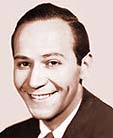
Frank Loesser
1910–1969 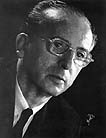
Frederick Hollander
1896–1979 Composed by Frederick Hollander with lyrics by Frank Loesser for a classic 1939 film, Destry Rides Again. Frederick Hollander – composerFrederick Hollander was a German composer, classically trained in Berlin, who migrated to USA from Nazi Germany in the mid 1930s. 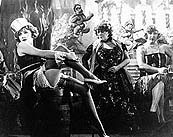
Marlene Dietrich
as "Lola Lola" in "Blue Angel" – 1930 While in Germany, apart from writing for and conducting opera, he composed for German film scores from the time that "talkies" began to be made. His film career began when he auditioned for the part of the pianist in the famous film "Blue Angel"; instead he was hired to write music for it. Out of this came the eternal "Falling in Love (Can't Help It)" sung by Marlene Dietrich. The film and particularly this song kick started the Dietrich legend Soon after arriving in the USA he began an association with Frank Loesser (among others). He wrote many "hits" for stage and screen, including a number for Marlene Dietrich such as "Awake in a Dream" Frank Loesser – lyricistBorn in New York, Frank Loesser became "one of the most versatile of Broadway composers". While he had no formal training, his father was a music and piano teacher. He began writing lyrics as a child. He had his start in Hollywood as a lyricist in 1936 when he was contracted by Universal Studios to write for film musicals In 1942, for the first time, he both composed and wrote the lyrics for a song; the WW2 song "Praise the Lord and Pass the Ammunition". Moving back to New York after WW2 he wrote a number of famous musicals for stage including "Guys and Dolls " and "How to Succeed in Business Without Trying". He wrote and collaborated on the scores for over sixty films; one of which was "Destry Rides Again" Destry Rides Again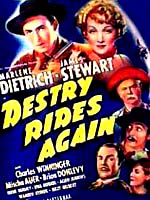
This 1939 film, directed by George Marshall is a romantic comedy that spoofs the Western film genre. The leads are played by Jimmy Stewart as "Destry", an unlikely Deputy Sheriff, and Marlene Dietrich as "Frenchy", a hard bitten Saloon Dancer and boyfriend of "Kent" (Brian Donlevy), the double dealing owner of the Last Chance Saloon". The town is controlled by a corrupt Mayor " The Plot When the Sheriff of Bottleneck is shot down, the Mayor appoints as the new Sheriff, a former deputy, now the town drunk, "Wash" (Charles Winniger). The Sheriff cleans up his act and hires the son of legendary Sheriff Destry who cleaned up Tombstone City. To the Sheriff's dismay, the son does not carry a gun (although he is a crack shot) and doesn't believe in gun fighting to uphold the law because it makes heroes of bad men". However Destry prevails by other means. He and Frenchy fall in love. At last Destry is cornered by the last of the gunmen but Frenchy leads the town's women against the gunmen forcing them to surrender Lyrics
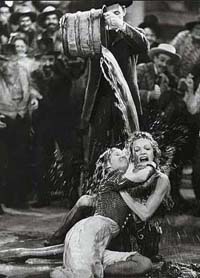
See what the boys in the backroom will have, And tell them I'm having the same. Go see what the boys in the backroom will have, And give them the poison they name. And when I die, don't spend my money On flowers and my picture in a frame. Just see what the boys in the backroom will have, And tell them I sighed, And tell them I cried, And tell them I died of the same. And when I die, don't buy a casket Of silver with the candles all aflame Just see what the boys in the backroom will have, And tell them I sighed, And tell them I cried, And tell them I died of the same. And when I die, don't pay the preacher For speaking of my glory and my fame Just see what the boys in the backroom will have, And tell them I sighed, And tell them I cried, And tell them I died of the same. |
